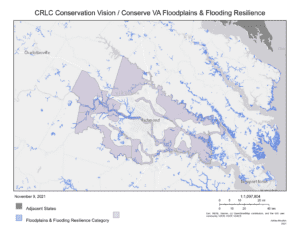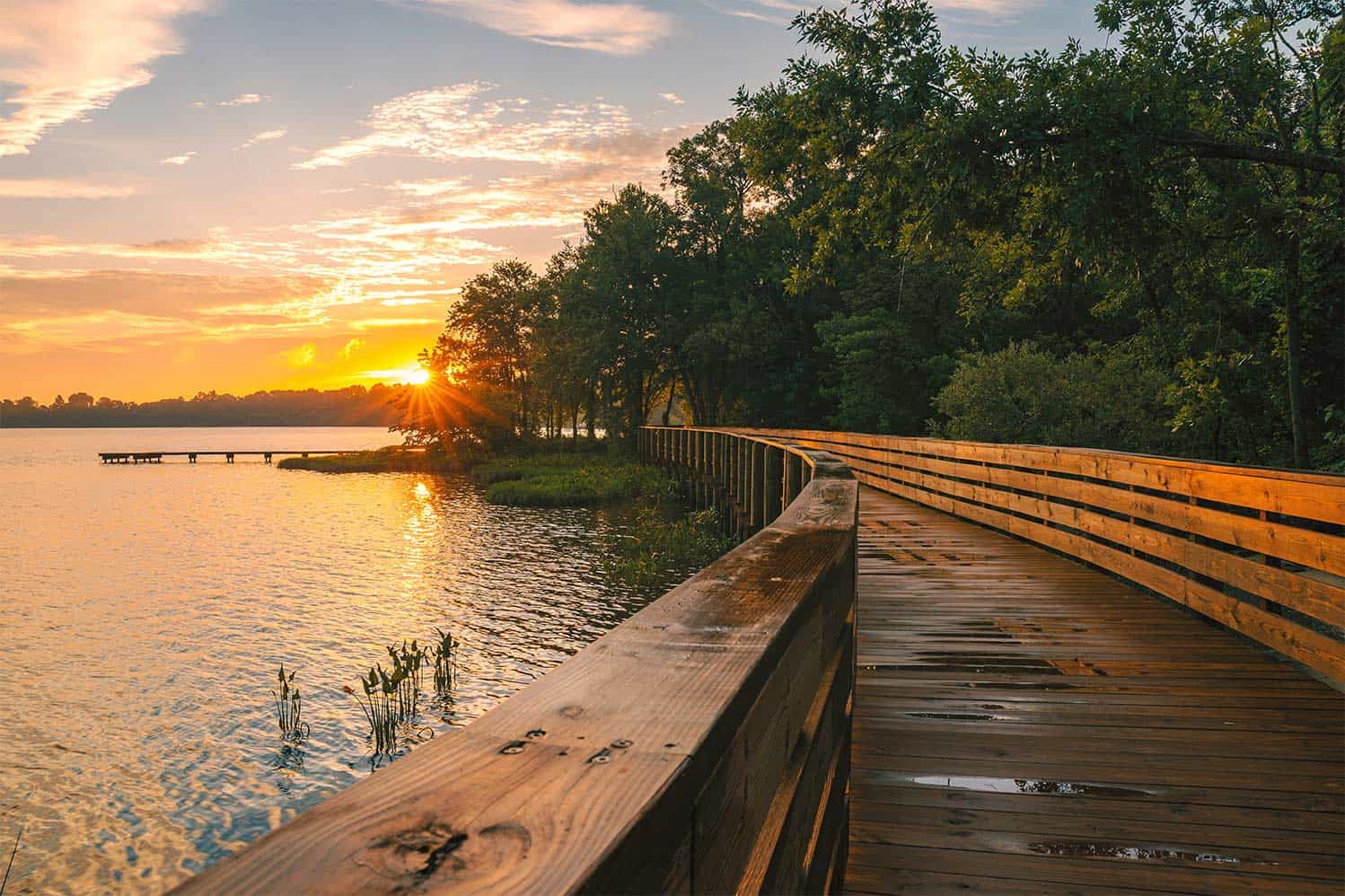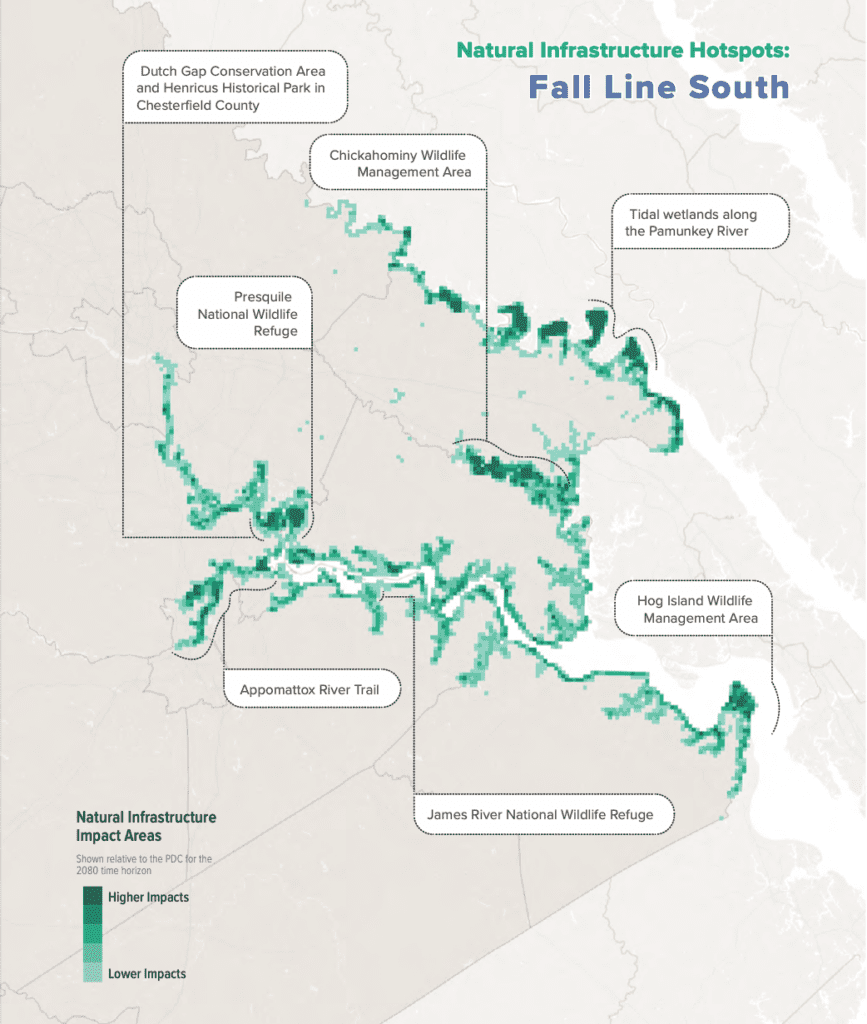Richmond lies 108 miles from the Atlantic Ocean and 93 miles from the Chesapeake Bay. Despite this distance from the areas that we typically think of as Virginia’s coast, tidal areas of Virginia’s Capital Region will be subject to extreme flooding due to sea level rise, according to models from the National Oceanic and Atmospheric Administration (NOAA) and the first Virginia Coastal Resilience Master Plan.
Climate change is a major threat to coastal populations and the industries upon which they depend. As scientific forecasts call for a rise in sea level by over 4 feet by 2080, our natural areas will also take a major hit. Across the Capital Region, we expect sea level rise to threaten 92% of our tidal wetlands, 62% of our upland habitat, and 10% of our conserved lands by 2080. You can explore these impacts in the Plan’s Virginia Coastal Resilience Web Explorer.
 Natural areas, including tidal wetlands and uplands, are our biggest natural defense against flooding. They act as a great green wall, offering critical wildlife habitat, water quality protection, outdoor recreation opportunities, and flood mitigation areas. Once they are permanently inundated due to climate change, much of their environmental benefits will be lost. Uplands—the forests, fields, and shrublands uphill of coastal wetlands—will only take up the slack if we plan for their transition to wetlands and if species adapt accordingly.
Natural areas, including tidal wetlands and uplands, are our biggest natural defense against flooding. They act as a great green wall, offering critical wildlife habitat, water quality protection, outdoor recreation opportunities, and flood mitigation areas. Once they are permanently inundated due to climate change, much of their environmental benefits will be lost. Uplands—the forests, fields, and shrublands uphill of coastal wetlands—will only take up the slack if we plan for their transition to wetlands and if species adapt accordingly.
We have to build this green wall of protected land. We can do this by conserving more lands in and around our coasts and tidal portions of the Appomattox, Chickahominy, James and Pamunkey Rivers and their tributaries. While working towards protecting 30% of our land resources by the year 2030, we also have to make up for a 10% expected loss in conserved lands due to permanent flooding. An accredited land trust such as CRLC will continue to play a significant role in implementing solutions that match this pace of change.
To prevent this net loss, CRLC and our partners like Friends of the Lower Appomattox River (FOLAR) and Henricopolis Soil & Water Conservation District (HSWCD) are targeting land conservation through voluntary conservation easements and land purchase. We need to create protective buffers around parks, rivers, streams, and vulnerable communities. This effort can only be successful if our local government partners also avoid or mitigate development in the path of inundation. Let’s walk through our strategies:
Conservation easements allow landowners to protect their land with the help of a land trust. For example, Mrs. Green’s family land on the bank of the Appomattox River will frequently flood by the year 2040. She knows that is not much time, and needs to find a way to protect her family, in life and in property. By donating a conservation on her property to a land trust like CRLC, she can continue to own her land, while receiving a one-time tax benefit. This agreement could give her the cash she needs to build flood protection, like raising her home or relocating. Mrs. Green is also comforted to know that her conserved land will protect her community, by buffering the town from the river’s flooding banks.
Land acquisition by governments or by land trusts like CRLC can offer similar benefits. For example, Danny and Omar Blue have been living and working their farm for 25 years. They don’t want to leave, but the persistent flooding on their property is a financial burden, damaging their crops and equipment. They decide to sell their land, but flooding does not make it an attractive purchase. Thankfully, a local land trust has been working with the town to conserve land. The land trust decides to purchase Mr. And Mr. Blue’s land, giving the couple the money that they need to buy a new home somewhere they know they will be safe from flooding. After the residents have moved on, the land trust plants flood prone grasses and trees, and hands the land over to the town to protect the community and open a new riverfront park.
Land conservation will be essential to coastal resilience efforts going forward. These strategies do not just result in flood protection, they open new public lands, open opportunities for wildlife to return, and empower landowners and local communities to take coastal resilience planning into their own hands. Let’s invest in building a stronger green wall, starting now.
View the Virginia Coastal Resilience Web Explorer here.

Peter Braun
CRLC Community Engagement Manager


